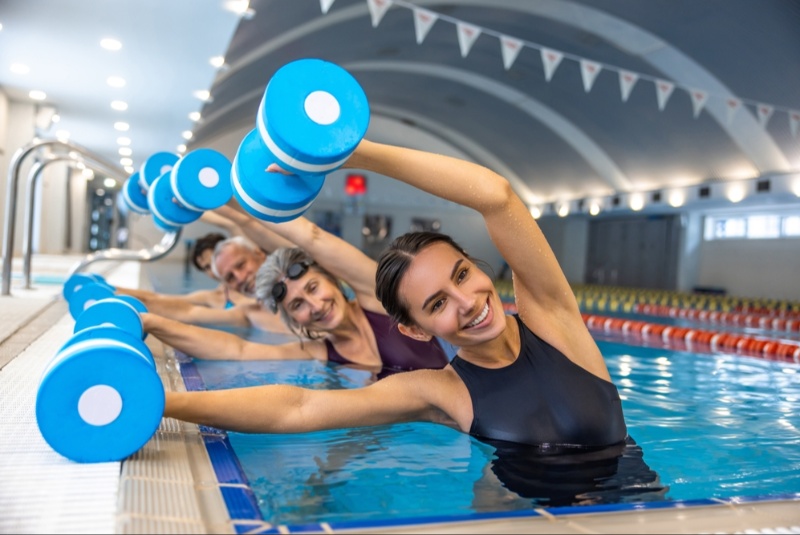Water workouts, or aqua fitness, are an excellent way to exercise without putting undue stress on your joints. Thanks to the buoyancy and resistance of water, pool exercises can be both low-impact and highly effective. This guide will explore various low-impact pool exercises suitable for all fitness levels, enhancing health and wellness.
Understanding the Benefits of Water Workouts
Exercising in water offers numerous benefits. The buoyancy reduces the impact on joints, making it ideal for those with arthritis, osteoporosis, or injuries. Water resistance helps in building muscle strength and endurance. Additionally, aqua workouts can improve cardiovascular health, flexibility, and balance.
Getting Started with Water Workouts
Before diving into water exercises, it's important to prepare. Choose a safe and comfortable pool environment. Wear a swimsuit that provides freedom of movement, and consider water shoes for extra grip. Always start with a warm-up to get your body acclimated to the water temperature and environment.
Aqua Jogging for Cardiovascular Health
Aqua jogging is a simple yet effective cardiovascular exercise. Mimic the motion of jogging without touching the pool floor. This exercise increases heart rate, improves endurance, and is gentle on the joints. For added intensity, use aqua joggers or flotation belts.
Water Aerobics for Overall Fitness
Water aerobics includes a variety of exercises like leg kicks, arm circles, and jumping jacks performed in the water. These movements increase heart rate and offer a full-body workout. Joining a water aerobics class can provide a structured routine and social interaction.
Strength Training with Water Resistance
Utilize the natural resistance of water for strength training. Exercises like arm curls, leg lifts, and squats performed in water provide resistance, helping to tone and strengthen muscles. Use foam dumbbells or webbed gloves for added resistance.
Yoga and Stretching in Water
Practicing yoga and stretching exercises in water can enhance flexibility and relaxation. The water’s buoyancy makes it easier to hold poses and stretch without strain. Focus on slow, deliberate movements and maintain each pose for several breaths.
Swimming Laps for Full-Body Workout
Swimming laps is a classic pool exercise that provides a full-body workout. It improves cardiovascular health, builds muscular strength, and enhances endurance. Vary your strokes (freestyle, breaststroke, backstroke) to engage different muscle groups.
Balance Exercises for Stability
Water is an ideal environment for practicing balance exercises. Stand on one leg, perform tai chi movements, or try aquatic yoga poses to improve stability and core strength. The water's resistance adds a challenge to balance exercises.

Low-Impact Water Therapy for Rehabilitation
For those in rehabilitation, water therapy exercises can aid in recovery. Gentle movements and stretches in water can help restore mobility and strength with minimal joint stress. Always consult with a healthcare provider or physical therapist for a tailored water therapy routine.
Interval Training for Weight Loss
Incorporate interval training into your water workout for effective weight loss. Alternate between high-intensity exercises (like fast-paced swimming or aqua jogging) and low-intensity recovery periods. This approach boosts metabolism and burns calories.
Breathing Techniques for Relaxation
Proper breathing is essential in water workouts. Focus on deep, rhythmic breathing to enhance relaxation and oxygen flow to muscles. Exercises like aqua yoga or tai chi in water can be particularly effective for practicing mindful breathing.
Incorporating Equipment for Enhanced Water Workouts
To elevate the intensity and variety of your water workouts, consider incorporating specialized aquatic equipment. Items like kickboards, foam noodles, and water dumbbells can add resistance and challenge to your exercises, making them more effective. For instance, using a kickboard for leg kicks focuses on lower body strength, while foam noodles can be used for balance and core stability exercises. Water dumbbells are excellent for upper body strength training, offering resistance that can be adjusted based on how deeply they are submerged. Experimenting with different equipment can keep your pool workouts diverse, engaging, and more beneficial.
Combining Water Workouts with Land-Based Exercises
For a well-rounded fitness regime, combine water workouts with land-based exercises. This approach allows you to reap the benefits of both environments. Water exercises are excellent for low-impact, resistance-based training, while land exercises can include weight training, cardio, or flexibility-focused activities like yoga or Pilates. By alternating between aquatic and land workouts, you can target different muscle groups, prevent workout monotony, and reduce the risk of overuse injuries. This holistic approach to fitness ensures a balanced and comprehensive exercise routine that caters to all aspects of physical health.
Safety Considerations in Water Workouts
Safety is paramount in water workouts. Always workout in a safe depth, stay hydrated, and avoid overexertion. If you're new to water workouts or have health concerns, consider working with an instructor to ensure exercises are performed safely and effectively.
Tracking Progress and Setting Goals
Set realistic goals for your water workouts and track your progress. Goals might include improving endurance, increasing strength, or enhancing flexibility. Keep a workout log or use a waterproof fitness tracker to monitor your achievements.
Water workouts offer a versatile and effective way to improve fitness with minimal impact on joints. Whether it's aqua jogging, water aerobics, or swimming, these exercises can benefit people of all ages and fitness levels. By incorporating a variety of low-impact pool exercises into your routine, you can enjoy improved health and wellness while making the most of the aquatic environment.




